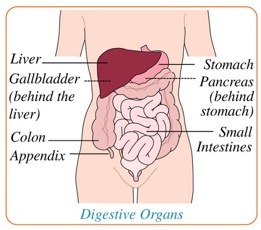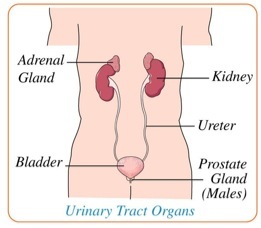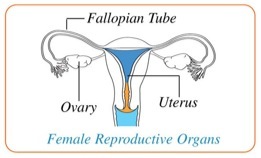-
Common Health Problems



Abdominal Pain
“When I got to school, my stomach did a lot of backflips because of all of the new foods. I miss my mom’s cooking.”
– John L., Notre Dame University
The abdomen is the body region between the lower ribs and the pelvis that contains many vital organs:
Abdominal pain can range from mild to severe: be dull or sharp; acute or chronic. Acute pain is sudden pain. Chronic pain can be constant or pain that recurs over time. The type of pain, its location, and other symptoms that come with it help suggest the cause.
Signs, Symptoms & Causes
There are many causes of abdominal pain. Common ones in students and the symptoms that accompany them are listed below.
Constipation
Constipation results from not drinking enough fluids, not eating enough dietary fiber, not being active enough, and from misusing laxatives. Symptoms of constipation are:
-
•A hard time passing stool, not being able to pass stool, and/or having very hard stools.
-
•Straining to have a bowel movement.
-
•Abdominal swelling or feeling of continued fullness after passing stool.
Gastroenteritis
Gastroenteritis is inflammation of the lining of the stomach and intestines. Causes include having an intestinal virus, food poisoning, and drinking contaminated water or too much alcohol. Symptoms of gastroenteritis include:
-
•Abdominal pain or cramping.
-
•Nausea and/or vomiting.
-
•Diarrhea.
-
•Fever and/or chills.
It may be hard to tell from symptoms if you have an intestinal virus or food poisoning. Suspect food poisoning if others who have eaten the same foods you did also have symptoms.
Lactose Intolerance
Lactose intolerance results from a lack of an enzyme (lactase) needed to digest the sugar (lactose) in dairy products. Symptoms of lactose intolerance are:
-
•Abdominal cramping, pain, and bloating after drinking milk or eating other dairy products.
-
•Gas and diarrhea.
Menstrual Cramps in Females
Hormones cause the uterus to go into spasms. Premenstrual bloating increases the abdominal pain. Symptoms of menstrual cramps are:
-
•Mild to severe abdominal pain.
-
•Back pain, fatigue, and/or diarrhea.
Peptic Ulcer
A peptic ulcer is an ulcer in the stomach or first section of the small intestine. Symptoms include:
-
•A gnawing or burning pain between the breastbone and navel. This is the most common symptom. The pain often occurs between meals and in the morning. It may last from a few minutes to a few hours and may be relieved with eating an antacids.
-
•Loss of appetite and weight loss.
-
•Nausea or vomiting dark, red blood or material that looks like coffee grounds.
-
•Bloody, black, or tarry stools.
The 2 most common factors associated with peptic ulcers are:
-
•An infection with Helicobacter pylori (H. pylori) bacteria.
-
•The repeated use of aspirin and other nonsteroidal anti-inflammatory drugs (NSAIDs), such as over-the-counter and prescribed ibuprofen.
Peptic ulcers are not caused by stress, but stress can aggravate them. (See “Stress.”)
Treatment
Treatment depends on the cause. The key is knowing when it’s just a minor problem like a mild stomach ache or when it’s something worse. Pain that persists can be a sign of a medical condition or illness. Very severe abdominal pain usually requires immediate medical care.

Self-Care
To Help Ease Pain in General
-
•Place a hot water bottle or a heating pad, set on low, over the area of pain.
-
•Find a comfortable position. Relax.
-
•Take an over-the-counter medicine for pain that does not cause stomach upset. (See “Pain Relievers.”)
-
•Don’t wear tight-fitting clothes.
-
•Don’t do strenuous exercise.
-
•Eat foods as tolerated.
For Constipation
-
•Eat foods high in fiber: Bran; whole-grain breads and cereals; and fresh fruits and vegetables.
-
•Drink at least 1-1/2 to 2 quarts of water and other liquids every day. Hot water, tea, or coffee may help stimulate the bowel.
-
•Get plenty of exercise.
-
•Don’t resist the urge to have a bowel movement.
-
•If you take antacids or iron supplements and get constipated easily, discuss the use of these with your health care provider.
-
•Don’t use “stimulant” laxatives, such as Ex-Lax, or enemas without your provider’s okay. Long-term use of them can make you even more constipated and lead to a mineral imbalance and reduced nutrient absorption. If needed, take an over-the-counter bulk-forming laxative, such as Metamucil.
For Food Poisoning
-
•To prevent food poisoning:
-
-Wash your hands and food preparation surfaces and utensils, especially after handling raw meat and eggs.
-
-Cook foods to a safe temperature. Follow product and/or recipe directions.
-
-Refrigerate perishable foods promptly. These include milk, cheese, meat, poultry, eggs, and fish. Refrigerate leftovers, and use them within 3 to 4 days.
-
-Hot foods should be kept at or above 140ºF. Cold foods should be kept at or below 40ºF. Carry items in a thermos or with a cold pack, if necessary.
-
-When in doubt, throw it out.
-
•When you have food poisoning, follow self-care measures in “Vomiting & Nausea” on page 66.
For Lactose Intolerance
See “Self-Care for Lactose Intolerance.”
For Menstrual Cramps
-
•Take an over-the-counter medicine for pain. (See “Pain Relievers.”)
-
•Drink hot tea (regular, chamomile, or mint).
-
•Hold a heating pad or hot water bottle on your abdomen or lower back.
-
•Take a warm bath.
-
•Gently massage your abdomen.
-
•Do mild exercises, such as yoga and walking.
-
•When you can, lie on your back and support your knees with a pillow.
-
•Rest. Avoid stress as your period approaches.
{Note: If you get stomach aches due to stress, see “Stress” for information on how to deal with it.}
Is the abdominal pain very severe or sudden, extreme, and constant? Is the pain so bad that you can’t move or does it get a lot worse when you move?
Questions to Ask





Are all of these symptoms of appendicitis present?
-
•You have not had your appendix removed.
-
•Pain and tenderness that usually start in the upper part of the stomach or around the belly button and move to the lower right part of the abdomen. The pain can be sharp, severe, and felt more when the lower right abdomen is touched.
-
•Nausea, vomiting, or no appetite.
-
•Mild fever.


For females, do you have the following signs and symptoms of an ectopic pregnancy or pelvic inflammatory disease (PID)?
-
•You are sexually active and have missed one or more periods or have vaginal bleeding you can’t explain.
-
•Cramping or pain that can be severe in your lower abdomen.
-
•Sudden fainting or dizziness.


Do you have signs and symptoms of an acute kidney infection?


Do you have the following signs and symptoms of kidney stones?
-
•The pain started in your side before it moved to your abdomen or groin.
-
•You pass no urine or it is painful to pass urine.
-
•Your urine is bloody, cloudy, and/or has a foul odor.
-
•You pass urine often but only pass small amounts.
-
•Your temperature is over 101°F (38ºC).







With abdominal pain, do you have any of these problems?
-
•The whites of your eyes or your skin looks yellow.
-
•Severe diarrhea or constipation lasts more than a week.
-
•Skin on the abdomen is sensitive.
-
•You have a bulge or discomfort (when pressed) anywhere on the abdomen.



Do you have signs and symptoms of a bladder infection?



With abdominal pain, are any of these conditions present?
-
•Continued belching, nausea, gas, or gurgling noises.
-
•Pain worsens when you bend over or lie down.
-
•You could be pregnant.
-
•Menstrual cramps are severe enough to keep you from going to classes nearly every month.


Copyright © 2007, American Institute for Preventive Medicine. All rights reserved.


